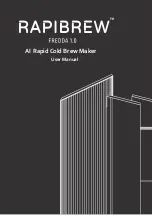
7
Gas Cylinders and Gas Build up
• Use only compressed gas cylinders containing the correct shielding gas for the process used
and properly operating regulators designed for the gas and pressure used. All hoses, fittings,
etc. should be suitable for the application and maintained in good condition.
• Always keep cylinders in an upright position securely chained to an undercarriage or fixed
support.
• Cylinders should be located:
- Away from areas where they may be struck or subjected to physical damage.
- At a safe distance from arc welding or cutting operations and any other source of heat,
sparks, or flame.
• Never allow the electrode, electrode holder or any other electrically “hot” parts to touch a gas
cylinder.
• Keep your head and face away from the cylinder valve outlet when opening the cylinder
valve.
• Valve protection caps should always be in place and hand tight except when the cylinder is in
use or connected for use.
Shielding gas cylinders contain gas under high pressure. If damaged, a cylinder can explode.
Because gas cylinders are normally part of the welding process, be sure to treat them carefully.
CYLINDERS can explode if damaged.
• Protect gas cylinders from excessive heat, mechanical shocks, physical damage, slag, open
flames sparks, and arcs.
• Insure cylinders are held secure and upright to prevent tipping or falling over.
• Never allow the welding electrode or earth clamp to touch the gas cylinder, do not drape
welding cables over the cylinder.
• Never weld on a pressurised gas cylinder, it will explode and kill you.
• Open the cylinder valve slowly and turn your face away from the cylinder outlet valve and gas
regulator.
The build up of gas can causes a toxic environment, deplete the oxygen content in the air
resulting in death or injury. Many gases used in welding are invisible and odorless.
• Shut off shielding gas supply when not in use.
• Always ventilate confined spaces or use approved air-supplied respirator.
Electric and Magnetic Fields.
Electric current flowing through any conductor causes localized Electric and Magnetic Fields
(EMF). The discussion on the effect of EMF is ongoing in the entire world. Up to now, no mate-
rial evidences show that EMF may have effects on health. However, the research on the effect
of EMF is still ongoing. Before any conclusion, we should minimize exposure to EMF as few as
possible.
In order to minimize EMF, we should use the following procedures:
• Route the electrode and work cables together – Secure them with tape when possible.
• All cables should be put away and far from the operator.
• Never coil the power cable around your body.
• Make sure welding machine and power cable to be far away from the operator as far as
possible according to the actual circumstance.
• Connect the work cable to the workpiece as close as possible to the area being welded.
• The people with heart-pacemaker should be away from the welding area.
• Sparks and spatter are thrown from the welding arc. Wear oil free protective garments such
as leather gloves, heavy shirt, cuff less trousers, high shoes and a cap over your hair. Wear
earplugs when welding out of position or in confined places. Always wear safety glasses with
side shields when in a welding area.
• Connect the work cable to the work as close to the welding area as practical. Work cables
connected to the building framework or other locations away from the welding area increase
the possibility of the welding current passing through lifting chains, crane cables or other
alternate circuits. This can create fire hazards or overheat lifting chains or cables until they
fail








































